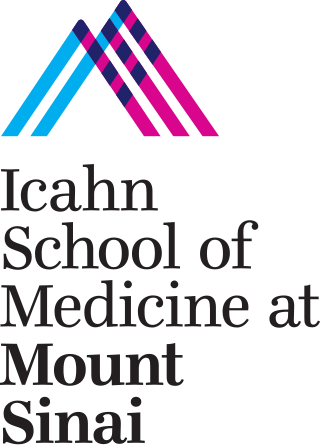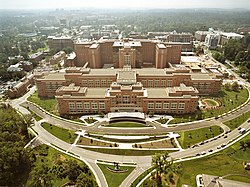
The National Institutes of Health, commonly referred to as NIH, is the primary agency of the United States government responsible for biomedical and public health research. It was founded in the late 1880s and is now part of the United States Department of Health and Human Services. Many NIH facilities are located in Bethesda, Maryland, and other nearby suburbs of the Washington metropolitan area, with other primary facilities in the Research Triangle Park in North Carolina and smaller satellite facilities located around the United States. The NIH conducts its own scientific research through the NIH Intramural Research Program (IRP) and provides major biomedical research funding to non-NIH research facilities through its Extramural Research Program.

The Albert Einstein College of Medicine is a private, nonprofit, research-intensive medical school in the Morris Park neighborhood of the Bronx, New York City, United States. Founded in 1953, Einstein operates as an independent degree-granting institution as part of the integrated health care Montefiore Health System and also has affiliation with Jacobi Medical Center.

Health informatics is the field of science and engineering that aims at developing methods and technologies for the acquisition, processing, and study of patient data, which can come from different sources and modalities, such as electronic health records, diagnostic test results, medical scans. The health domain provides an extremely wide variety of problems that can be tackled using computational techniques.

Cedars-Sinai Medical Center is a nonprofit, tertiary, 886-bed teaching hospital and multi-specialty academic health science center located in Los Angeles, California. Part of the Cedars-Sinai Health System, the hospital has a staff of over 2,000 physicians and 10,000 employees, supported by a team of 2,000 volunteers and more than 40 community groups. As of 2022-23, U.S. News & World Report ranked Cedars-Sinai among the top performing hospitals in the western United States. Cedars-Sinai is a teaching hospital affiliate of David Geffen School of Medicine at the University of California, Los Angeles (UCLA), which was ranked in the top 20 on the U.S. News 2023 Best Medical Schools: Research.
The National Institute of Arthritis and Musculoskeletal and Skin Diseases (NIAMS) is one of the institutes and centers that make up the National Institutes of Health, an agency of the United States Department of Health and Human Services (HHS).
The Virginia–Maryland College of Veterinary Medicine is a state-supported college of two states, Virginia and Maryland, filling the need for veterinary medicine education in both states. Students from both states are considered "in-state" students for admissions purposes.

The Icahn School of Medicine at Mount Sinai, formerly the Mount Sinai School of Medicine, is a private medical school in New York City, New York, United States. The school is the academic teaching arm of the Mount Sinai Health System, which manages eight hospital campuses in the New York metropolitan area, including Mount Sinai Hospital and the New York Eye and Ear Infirmary.
The Duke University School of Medicine, commonly known as Duke Med, is the medical school of Duke University. It is located in the Collegiate Gothic-style West Campus of Duke University in Durham, North Carolina. The School of Medicine, along with the Duke University School of Nursing, Duke University Hospital, Duke Regional Hospital, Duke Children's Hospital, Duke Raleigh Hospital, and other affiliated hospitals, clinics, and laboratories, make up the Duke University Health System. Established in 1925 by James B. Duke, the School of Medicine has earned its reputation as an integral part of one of the world's foremost patient care and biomedical research institutions.

The University of Virginia School of Medicine is the graduate medical school of the University of Virginia. The school's facilities are on the University of Virginia grounds adjacent to Academical Village in Charlottesville, Virginia. Founded in 1819 by Thomas Jefferson, UVA SoM is the tenth oldest medical school in the United States, and is ranked 31st in research-oriented medical schools by U.S. News & World Report, and as of 2021, is ranked nineteenth in the nation in primary care. The School of Medicine confers Doctor of Medicine (M.D.) and Doctor of Philosophy (PhD) degrees, and is closely associated with both the University of Virginia Health System and Inova Health System.
Wake Forest University School of Medicine is the medical school of Wake Forest University, with two campuses located in Winston-Salem, North Carolina and Charlotte, North Carolina, United States. It is affiliated with Atrium Health Wake Forest Baptist, the academic medical center whose clinical arm is Atrium Health Wake Forest Baptist. In 2021, U.S. News & World Report ranked Wake Forest School of Medicine 48th best for research in the nation and 80th best for primary care. The School of Medicine also ranks in the top third of U.S. medical schools in funding from the National Institutes of Health (NIH).

Susan Shurin is a senior adviser at the National Cancer Institute. From 2006–2014, she served as Deputy and Acting Director of the National Heart, Lung, and Blood Institute (NHLBI) [NHLBI.nih.gov] at the National Institutes of Health [nih.gov] (NIH).

James K. Gilman, a retired United States Army Major General and physician from Hymera, Indiana, became the first chief executive officer of the NIH Clinical Center Jan. 9, 2017. The NIH Clinical Center is the nation's largest hospital devoted to clinical research.

The Renaissance School of Medicine (RSOM) is the graduate medical school of Stony Brook University located in the hamlet of Stony Brook, New York on Long Island. Founded in 1971, RSOM is consistently ranked the top public medical school in New York according to U.S. News & World Report. RSOM is one of the five Health Sciences schools under the Stony Brook Medicine healthcare system.

The NIH Intramural Research Program (IRP) is the internal research program of the National Institutes of Health (NIH), known for its synergistic approach to biomedical science. With 1,200 Principal Investigators and over 4,000 Postdoctoral Fellows conducting basic, translational, and clinical research, the NIH Intramural Research Program is the largest biomedical research institution on earth. The unique funding environment of the IRP facilitates opportunities to conduct both long-term and high-impact science that would otherwise be difficult to undertake. With rigorous external reviews ensuring that only the most outstanding research secures funding, the IRP is responsible for many scientific accomplishments, including the discovery of fluoride to prevent tooth decay, the use of lithium to manage bipolar disorder, and the creation of vaccines against hepatitis, Hemophilus influenzae (Hib), and human papillomavirus (HPV). In addition, the IRP has also produced or trained 21 Nobel Prize-winning scientists.

The Foundation for the National Institutes of Health (FNIH) is a not-for-profit, 501(c)(3) charitable organization established by the US Congress in 1990. Located in North Bethesda, MD, the FNIH raises private-sector funds, and creates and manages alliances with public and private institutions in support of the mission of the National Institutes of Health (NIH).
The National Institutes of Health Clinical Research Training Program (CRTP) was a one-year education program aimed at highly qualified, research-oriented medical and dental students wanting to learn the theory and practice of clinical and translational research that ran from 1997 to 2012. It covered among other topics clinical research design, data analysis, bioethics, and critical review of the medical literature; but most of each fellow's time was devoted to conducting supervised clinical or translational research in their area of interest.

Judith L. Vaitukaitis was a reproductive neuroendocrinologist and clinical researcher who played a key role in developing a biochemical assay in the early 1970s that ultimately led to the creation of the home pregnancy test. She served for 12 years as director of the US National Center for Research Resources (NCRR) at the US National Institutes of Health (NIH).

John I. Gallin is an American medical researcher who has contributed to the understanding of innate immunity but especially chronic granulomatous disease, a phagocyte disorder. Gallin was appointed director of the NIH Clinical Center on May 1, 1994, and served until January 8, 2017. He serves as the chief scientific officer for the Clinical Center and associate director for clinical research at the National Institutes of Health.

Gerald T. Keusch is an American physician-scientist and academic administrator. Keusch is the associate provost for global health at Boston University Medical Campus and a professor of international health and medicine at Boston University School of Public Health. He was the director of John E. Fogarty International Center and the associate director of international research at the National Institutes of Health from 1998 to 2003.

Janine Austin Clayton is an American ophthalmologist. She is the NIH associate director for research on women's health and director of the Office of Women's Health. Clayton was previously the deputy clinical director of the National Eye Institute.


























